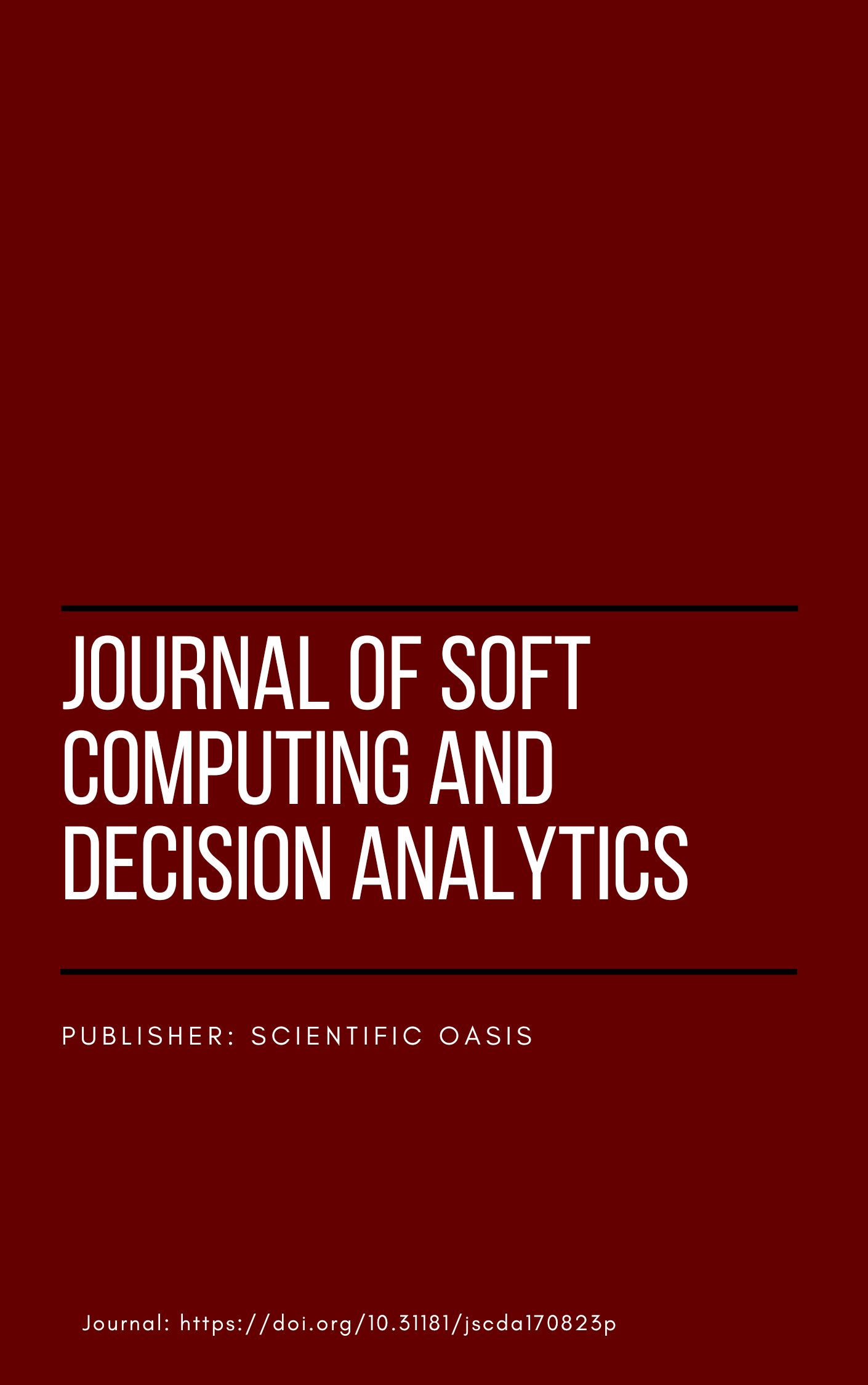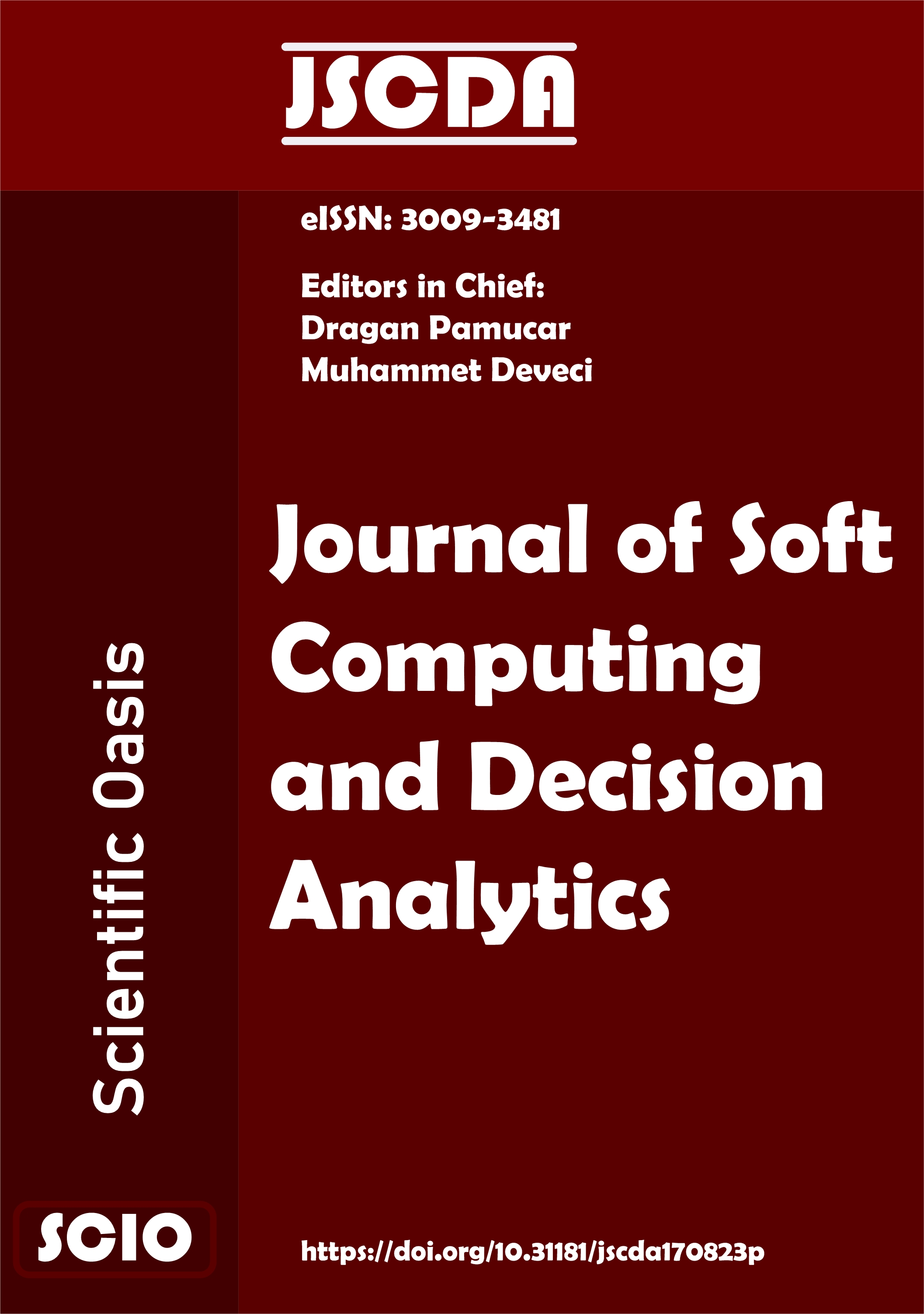A Belief Similarity Measure for Dempster-Shafer Evidence Theory and Application in Decision Making
DOI:
https://doi.org/10.31181/jscda21202443Keywords:
Dempster-Shafer evidence theory, Belief similarity measure, Belief entropy, Decision makingAbstract
How to effectively deal with uncertain and imprecise information in decision making is a complex task. Dempster-Shafer evidence theory (DSET) is widely used for handling such challenges due to its ability to model uncertainty and imprecision. However, Dempster's rule can sometimes yield counterintuitive results when dealing with highly conflicting evidence. In this paper, we introduce a novel belief sine similarity measure, called $BS^2M$, which effectively measures the discrepancy between different pieces of evidence. We also establish that $BS^2M$ possesses important properties such as boundedness, symmetry, and non-degeneracy. Building upon $BS^2M$, we present a new method for decision making. The proposed method considers both the credibility and the information volume of each evidence, providing a more comprehensive reflection of their importance. To validate our method, we conduct experiment in target recognition application, demonstrating the effectiveness and rationality of the proposed method.
References
Lin, Y., Li, Y., Yin, X., & Dou, Z. (2018). Multisensor fault diagnosis modeling based on the evidence theory. IEEE Transactions on Reliability, 67(2), 513–521. https://doi.org/10.1109/TR.2018.2800014.
Liu, Z., Cao, Y., Yang, X., & Liu, L. (2023). A new uncertainty measure via belief Renyi entropy in Dempster-Shafer theory and its application to decision making. Communications in Statistics-Theoryand Methods, https://doi.org/10.1080/03610926.2023.2253342.
Liu, Z., Deveci, M., Pamucar, D., & Pedrycz, W. (2024). An effective multi-source data fusion approach based on α-divergence in belief functions theory with applications to air target recognition and fault diagnosis. Information Fusion, 110, 102458. https://doi.org/10.1016/j.inffus.2024.102458.
Farooq, D. (2024). Application of pythagorean fuzzy analytic hierarchy process for assessing driver behavior criteria associated to road safety. Journal of Soft Computing and Decision Analytics, 2(1), 144-158. https://doi.org/10.31181/jscda21202439.
Liu, Z. (2024d). Hellinger distance measures on pythagorean fuzzy environment via their applications. International Journal of Knowledge-based and Intelligent Engineering Systems, https://doi.org/10.3233/KES-230150.
Liu, Z., & Letchmunan, S. (2024a). Enhanced fuzzy clustering for incomplete instance withevidence combination. ACM Transactions on Knowledge Discovery from Data, 18(3), 1–20. https://doi.org/10.1145/3638061.
Qiu, H., Liu, Z., & Letchmunan, S. (2024). Incm: Neutrosophic c-means clustering algorithm for interval-valued data. Granular Computing, 9(2), 34. https://doi.org/10.1007/s41066-024-00452-y.
Liu, Z., Qiu, H., & Letchmunan, S. (2024). Self-adaptive attribute weighted neutrosophic means clustering for biomedical applications. Alexandria Engineering Journal, 96, 42-57. https://doi.org/10.1016/j.aej.2024.03.092.
Dagistanli, H. A. (2024). An interval-valued intuitionistic fuzzy vikor approach for r&d project selection in defense industry investment decisions. Journal of Soft Computing and Decision Analytics,2(1), 1-13. https://doi.org/10.31181/jscda21202428.
Li, X., Liu, Z., Han, X., Liu, N., & Yuan, W. (2023). An intuitionistic fuzzy version of Hellinger distance measure and its application to decision-making process. Symmetry, 15(2), 500. https://doi.org/10.3390/sym15020500.
Liu, Z. (2024). A distance measure of fermatean fuzzy sets based on triangular divergence and its application in medical diagnosis. Journal of Operations Intelligence, 2(1), 167-178. https://doi.org/10.31181/jopi21202415.
Liu, Z. (2024). Fermatean fuzzy similarity measures based on tanimoto and sørensen coefficients with applications to pattern classification, medical diagnosis and clustering analysis. Engineering Applications of Artificial Intelligence, 132, 107878. https://doi.org/10.1016/j.engappai.2024.107878.
Alcantud, J. C. R., Feng, F., & Yager, R. R. (2020). An N-soft set approach to rough sets. IEEE Transactions on Fuzzy Systems, 28(11), 2996-3007. https://doi.org/10.1109/TFUZZ.2019.2946526.
Liu, J., Chen, Z., Chen, Y., Zhang, Y., & Li, C. (2021). Multi-attribute group decision making based on interval-valued neutrosophic n-soft sets. Granular Computing, 6, 1009-1023. https://doi.org/10.1007/s41066-020-00244-0.
Liu, Z. (2023). An effective conflict management method based on belief similarity measure and entropy for multi-sensor data fusion. Artificial Intelligence Review, 15495-15522. https://doi.org/10.1007/s10462-023-10533-0.
Liu, Z. (2024). An evidential sine similarity measure for multisensor data fusion with its applications. Granular Computing, 9(1), 4. https://doi.org/10.1007/s41066-023-00426-6.
Liu, Z., & Letchmunan, S. (2024). Representing uncertainty and imprecision in machine learning:A survey on belief functions. Journal of King Saud University-Computer and Information Sciences,101904. https://doi.org/10.1016/j.jksuci.2023.101904.
Aggarwal, M. (2017). Rough information set and its applications in decision making. IEEE Transactions on Fuzzy Systems, 25(2), 265-276. https://doi.org/10.1109/TFUZZ.2017.2670551.
Cheng, Y., Zhao, F., Zhang, Q., & Wang, G. (2021). A survey on granular computing and its uncertainty measure from the perspective of rough set theory. Granular Computing, 6, 3-17. https://doi.org/10.1007/s41066-019-00204-3.
Dempster, A. (1967). Upper and lower probabilities induced by a multivalued mapping. Annals of Mathematical Statistics, 325-339. https://doi.org/10.1214/aoms/1177698950.
Liu, Z. (2023). Credal-based fuzzy number data clustering. Granular Computing, 8(6), 1907–1924. https://doi.org/10.1007/s41066-023-00410-0
Liu, Z., Huang, H., Letchmunan, S., & Deveci, M. (2024). Adaptive weighted multi-view evidential clustering with feature preference. Knowledge-Based Systems, 294, 111770. https://doi.org/10.1016/j.knosys.2024.111770
Ma, Z., Liu, Z., Luo, C., & Song, L. (2021). Evidential classification of incomplete instance based on k-nearest centroid neighbor. Journal of Intelligent & Fuzzy Systems, 41(6), 7101-7115. https://doi.org/10.3233/JIFS-210991
Zhang, H., & Deng, Y. (2020). Weighted belief function of sensor data fusion in engine fault diagnosis. Soft Computing, 24(3), 2329-2339. https://doi.org/10.1007/s00500-019-04063-7
Zhang, L., & Xiao, F. (2022). A novel belief χ2 divergence for multisource information fusion and its application in pattern classification. International Journal of Intelligent Systems, 37(10), 7968-7991. https://doi.org/10.1002/int.22912
Huang, H., Liu, Z., Han, X., Yang, X., & Liu, L. (2023). A belief logarithmic similarity measure based on dempster-Shafer theory and its application in multi-source data fusion. Journal of Intelligent& Fuzzy Systems, 45(3), 4935-4947. https://doi.org/10.3233/JIFS-230207
Lyu, S., & Liu, Z. (2024). A belief Sharma Mittal divergence with its application in multi-sensor information fusion. Computational and Applied Mathematics, 43(1), 1-31. https://doi.org/10.1007/s40314-023-02542-0
Derraz, F., Pinti, A., Peyrodie, L., Bousahla, M., & Toumi, H. (2015). Joint variational segmentation of ct/pet data using non-local active contours and belief functions. Pattern Recognition and Image Analysis, 25(3), 407-412. https://doi.org/10.1134/S1054661815030049
Khalaj, F., & Khalaj, M. (2022). Developed cosine similarity measure on belief function theory: An application in medical diagnosis. Communications in Statistics-Theory and Methods, 51(9), 2858-2869. https://doi.org/10.1080/03610926.2020.1782935
Xiao, F. (2023). Gejs: A generalized evidential divergence measure for multisource information fusion. IEEE Transactions on Systems, Man, and Cybernetics: Systems, 53(4), 2246-2258. https://doi.org/10.1109/TSMC.2022.3211498
Zadeh, L. A. (1986). A simple view of the dempster-Shafer theory of evidence and its implication for the rule of combination. AI Mag., 7(2), 85-85. https://doi.org/10.1609/aimag.v7i2.542
Yager, R. R. (1987). On the Dempster-Shafer framework and new combination rules. Information Sciences, 41(2), 93-137. https://doi.org/10.1016/0020-0255(87)90007-7
Dubois, D., & Prade, H. (1988). Representation and combination of uncertainty with belief functions and possibility measures. Computational Intelligence, 4(3), 244-264. https://doi.org/10.1111/j.1467-8640.1988.tb00279.x
Smets, P. (1990). The combination of evidence in the transferable belief model. IEEE Transactions on Pattern Analysis and Machine Intelligence, 12(5), 447-458. https://doi.org/10.1109/34.55104
Gao, X., & Xiao, F. (2022). A generalized χ2 divergence for multisource information fusionand its application in fault diagnosis. International Journal of Intelligent Systems, 37(1), 5-29. https://doi.org/10.1002/int.2261
Gao, X., & Xiao, F. (2022). An improved belief χ2 divergence for dempster–shafer theory andits applications in pattern recognition. Computational and Applied Mathematics, 41(6), 1-22. https://doi.org/10.1007/s40314-022-01975-3
Murphy, C. K. (2000). Combining belief functions when evidence conflicts. Decision Support Systems, 29(1), 1-9. https://doi.org/10.1016/S0167-9236(99)00084-6
Wang, H., Deng, X., Jiang,W.,&Geng, J. (2021). A new belief divergence measure for dempster Shafer theory based on belief and plausibility function and its application in multi-source data fusion. Engineering Applications of Artificial Intelligence, 97, 104030. https://doi.org/10.1016/j.engappai.2020.104030.223
Deng, Y., Shi, W., Zhu, Z., & Liu, Q. (2004). Combining belief functions based on distance of evidence. Decision Support Systems, 38(3), 489-493. https://doi.org/10.1016/j.dss.2004.04.015
Jiang, W. (2018). A correlation coefficient for belief functions. International Journal of Approximate Reasoning, 103, 94-106. https://doi.org/10.1016/j.ijar.2018.09.001
Xiao, F. (2019). Multi-sensor data fusion based on the belief divergence measure of evidences and the belief entropy. Information Fusion, 46, 23-32. https://doi.org/10.1016/j.inffus.2018.04.003
Kaur, M., & Srivastava, A. (2023). A new divergence measure for belief functions and its applications. International Journal of General Systems, 52(4), 455-472. https://doi.org/10.1080/03081079.2022.2151006
Deng, Y. (2016). Deng entropy. Chaos, Solitons & Fractals, 91, 549-553. https://doi.org/10.1016/j.chaos.2016.07.014
Pan, L., Gao, X., Deng, Y., & Cheong, K. H. (2022). Enhanced mass Jensen–Shannon divergence for information fusion. Expert Systems with Applications, 209, 118065. https://doi.org/10.1016/j.eswa.2022.118065.224
Downloads
Published
Issue
Section
License
Copyright (c) 2024 Scientific Oasis

This work is licensed under a Creative Commons Attribution 4.0 International License.
















